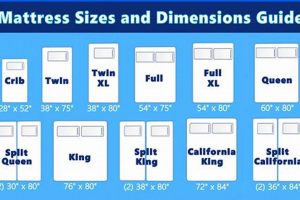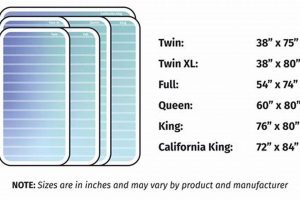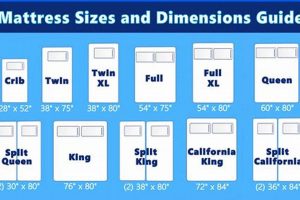Dimensions of sleeping surfaces designed for infants and young children within the confines of a cot, or crib, are a critical consideration for safety and comfort. These dimensions are typically standardized to ensure compatibility with available cot models and to mitigate risks associated with gaps between the mattress and the cot frame. A correctly sized sleeping surface prevents potential entrapment hazards for the child.
Appropriate sizing offers several key benefits, including a safer sleep environment, improved comfort for the child, and compliance with safety regulations. Historically, inconsistent dimensions led to increased risks of injury. Current standardization efforts aim to create a more uniform and secure environment, promoting parental peace of mind and supporting healthy sleep patterns for infants and toddlers.
The following sections will delve into specific dimensional standards, materials commonly used in their construction, and factors to consider when selecting the optimal sleeping surface for a cot.
Considerations for Selecting Appropriate Dimensions of Infant Sleeping Surfaces
The following recommendations offer guidance on choosing an appropriate infant sleeping surface to ensure both safety and comfort within a cot environment.
Tip 1: Verify Dimensional Standards: Prior to purchase, confirm that the specified dimensions adhere to recognized safety standards established by regulatory bodies. These standards typically outline acceptable ranges for length, width, and thickness.
Tip 2: Measure Interior Cot Dimensions: Accurately measure the interior dimensions of the cot frame to ensure a snug fit. Excessive gaps between the sleeping surface and the cot sides can pose a safety risk.
Tip 3: Assess Mattress Firmness: Select a sleeping surface that provides adequate firmness to reduce the risk of suffocation. A surface that is too soft can conform to the infant’s face, obstructing breathing.
Tip 4: Evaluate Material Composition: Review the material composition of the sleeping surface, prioritizing hypoallergenic and non-toxic materials. Certifications indicating low chemical emissions are desirable.
Tip 5: Inspect Seam Integrity: Carefully inspect the seams of the sleeping surface cover for durability and resistance to tearing. Weak seams can compromise the integrity of the product and create potential hazards.
Tip 6: Confirm Waterproof or Water-Resistant Properties: Ensure that the sleeping surface is waterproof or water-resistant to prevent moisture absorption and bacterial growth. Regular cleaning and maintenance are essential.
Tip 7: Consider Long-Term Use: If the cot is intended for extended use, choose a sleeping surface that offers adequate support and comfort as the child grows. Some models offer adjustable firmness levels.
Adherence to these recommendations promotes a safer and more comfortable sleeping environment for infants, mitigating potential risks associated with improperly sized or constructed infant sleeping surfaces.
The concluding section will provide further insights on maintaining and caring for the selected sleeping surface to ensure its longevity and continued safety.
1. Standard Dimensions (Length x Width)
The relationship between standard dimensions (length x width) and cot mattress sizes is one of definitional inclusion and critical safety. Standard dimensions represent the primary components defining the overall cot mattress size. Precise length and width measurements are not merely descriptive; they are prescriptive, dictated by safety regulations designed to minimize risks to infants. An instance of non-compliance is a mattress that is too small for a standard cot, creating gaps where an infant could become entrapped, leading to potential suffocation or injury. Conversely, a mattress too large could buckle or bow, also presenting safety hazards and potentially damaging the cot itself.
For example, in the United States, the Consumer Product Safety Commission (CPSC) mandates specific interior dimensions for cribs, and therefore, indirectly regulates the dimensions of the mattress intended for use within those cribs. The standard US crib mattress size is approximately 27 1/4 inches wide and 51 5/8 inches long. These fixed dimensions ensure that the mattress fits snugly within a compliant crib, eliminating dangerous gaps. Deviations from these standard dimensions, even minor ones, can render a mattress unsuitable and potentially unsafe. Furthermore, manufacturers adhere to these standards to ensure their products are compatible and readily interchangeable.
In summary, the standard dimensions (length x width) are not simply attributes of cot mattress sizes; they are core defining parameters governed by safety standards. Understanding this relationship is practically significant for both manufacturers and consumers, ensuring the selection and use of appropriate mattresses, thereby promoting infant safety and regulatory compliance. Deviations from these standards carry potential legal ramifications for manufacturers and critical safety risks for infants.
2. Mattress Thickness
Mattress thickness is a crucial dimensional attribute directly impacting the safety and efficacy of cot mattress sizes. It influences factors such as structural integrity, infant accessibility to cot rails, and overall sleep comfort. Deviation from recommended thickness ranges can compromise safety standards and potentially endanger the infant.
- Impact on Cot Rail Height
Mattress thickness affects the effective height of the cot rails. A mattress that is too thick reduces the distance between the mattress surface and the top of the rails, increasing the risk of a child climbing out. Conversely, a mattress that is too thin might not adequately fill the space, increasing the risk of entrapment. For instance, safety standards often specify a minimum rail height to prevent falls, which is directly dependent on the installed mattress thickness.
- Support and Spinal Alignment
The thickness of a cot mattress contributes to its overall support and ability to maintain proper spinal alignment for the infant. Insufficient thickness may lead to inadequate support, potentially causing discomfort or affecting spinal development. Optimal thickness provides a balance between firmness and cushioning, promoting healthy sleep posture. For example, mattresses made of high-density foam often require a certain thickness to provide adequate compression and support.
- Material Compression and Durability
Thickness plays a role in the long-term durability and compression resistance of a cot mattress. Thicker mattresses may exhibit greater resistance to compression over time, maintaining their shape and support capabilities. This is particularly relevant for mattresses made of materials that tend to compress, such as certain types of foam. Consider a scenario where a thinner mattress compresses significantly over time, reducing the effective rail height and compromising safety.
- Compatibility with Fitted Sheets
Mattress thickness also influences compatibility with fitted sheets. Sheets designed for a specific thickness range might not fit properly on mattresses outside that range, leading to loose or excessively tight fits. Loose sheets can pose a suffocation hazard, while excessively tight sheets can distort the mattress shape and compromise its support. Sheet manufacturers often specify recommended mattress thickness ranges for their products.
In summary, mattress thickness is an inextricable aspect of cot mattress sizes, directly influencing cot rail height, support, material durability, and sheet compatibility. Precise thickness values are guided by safety standards and designed to ensure infant safety and comfort within the confined space of the cot.
3. Corner Radius
The corner radius of a cot mattress, although seemingly a minor detail, bears a significant relationship to cot mattress sizes and overall safety within the cot environment. The design of the corners directly affects the fit and mitigates potential hazards associated with gaps.
- Ensuring a Snug Fit
A properly specified corner radius ensures the mattress fits snugly into the corners of the cot frame. Sharp, pointed corners on the mattress could create small gaps between the mattress and the frame, while overly rounded corners may leave larger, more hazardous gaps. The intended design is for the corner radius of the mattress to closely match the internal corner curvature of the cot.
- Minimizing Entrapment Risk
The primary purpose of a consistent corner radius is to minimize the risk of infant entrapment. Gaps created by mismatched corner designs can allow a small child to become wedged between the mattress and the cot frame, posing a suffocation or injury risk. Regulators often specify acceptable corner radius tolerances to limit this risk. An example would be a mandated radius of curvature that leaves no more than a few millimeters of space at each corner.
- Influence on Material Stress and Durability
The corner radius influences the stress distribution within the mattress material, particularly the outer covering. Sharply angled corners can create stress concentration points, potentially leading to premature wear or tearing of the material. A well-designed corner radius helps distribute stress more evenly, enhancing the durability and longevity of the mattress. Mattresses with overly sharp corners are more susceptible to damage from friction against the cot frame.
- Compatibility with Fitted Sheets
Corner radius also affects the compatibility of the mattress with fitted sheets. Sheets designed for mattresses with rounded corners may not fit properly on mattresses with more angular corners, and vice versa. An improper fit can lead to the sheet slipping off, creating a potential entanglement hazard. Standardized corner radii contribute to greater consistency in sheet fit, thereby enhancing safety.
In conclusion, corner radius is an essential aspect of cot mattress sizes, impacting fit, safety, durability, and sheet compatibility. Precise specification and adherence to standards for corner radii are critical for ensuring a safe and functional sleeping environment for infants within a cot.
4. Edge Firmness
Edge firmness, in relation to cot mattress sizes, represents a critical safety parameter affecting the likelihood of infant entrapment and the overall stability of the sleeping surface. The consistency and structural integrity of the mattress edge are essential considerations for mitigating potential hazards within the cot environment.
- Entrapment Prevention
The primary function of adequate edge firmness is to prevent infant entrapment between the mattress and the cot frame. A yielding edge can allow a small child to roll into the gap, potentially leading to suffocation. Stiffer edges reduce the likelihood of such occurrences, maintaining a consistent and secure boundary. Regulations often specify minimum edge firmness values to ensure adequate safety. For example, some standards require edges to withstand a specific force without significant deformation.
- Structural Stability
Edge firmness contributes to the overall structural stability of the mattress. A well-supported edge prevents the mattress from sagging or deforming over time, maintaining its shape and ensuring a consistent sleep surface. Insufficient edge support can lead to uneven weight distribution, potentially compromising the mattress’s ability to provide proper support and increasing the risk of rolling. High-density foam or reinforced edge supports are often used to enhance structural stability.
- Facilitating Independent Movement
Edge firmness provides a stable boundary that assists infants in independent movement within the cot. A firm edge can serve as a support point for the child as they learn to roll, sit, and stand. Weak edges, on the other hand, may yield or collapse under pressure, hindering the child’s ability to maneuver and increasing the risk of falls. Consider the scenario of an infant attempting to pull themselves up to a standing position; a firm edge provides the necessary support, while a soft edge may buckle, causing the child to lose balance.
- Material Composition and Construction
The edge firmness of a cot mattress is directly influenced by its material composition and construction techniques. High-density foam, reinforced coils, or specialized edge supports are commonly employed to enhance firmness and durability. Variations in material density and construction can result in significant differences in edge firmness, impacting the overall safety and performance of the mattress. For example, a mattress with a reinforced steel perimeter may exhibit significantly greater edge firmness than one constructed solely of low-density foam.
In summary, edge firmness is an indispensable characteristic of cot mattress sizes, directly impacting safety, stability, and infant mobility. Adherence to specific edge firmness standards is critical for ensuring a safe and supportive sleeping environment for infants, minimizing the risks associated with entrapment and promoting healthy development.
5. Compression Rate
The compression rate of a cot mattress is intrinsically linked to its size, performance, and, most importantly, its safety. Compression rate refers to the degree to which a mattress material deforms under a specific load over time. This parameter is crucial because it dictates the mattress’s ability to provide consistent support and maintain its structural integrity, both of which directly affect the infant’s well-being. A mattress with a high compression rate will flatten significantly under the infant’s weight, potentially compromising spinal alignment and increasing the risk of the infant sinking into the material, creating a suffocation hazard. A low compression rate, conversely, ensures consistent support across the entire surface, preventing localized sinking and maintaining a firm, safe sleep environment. The connection can be seen through regulatory standards; for instance, certain safety certifications require mattresses to exhibit compression rates within specified limits to ensure that they maintain their shape and support capabilities under typical use conditions. This rate is measured following established testing procedures, often including applying a known weight to the mattress and recording the extent of deformation over a set period.
Beyond safety, the compression rate also impacts the longevity and overall performance of the mattress. A mattress with a higher compression rate is likely to degrade more rapidly, losing its support and shape over time. This necessitates more frequent replacement, increasing costs and potentially exposing the infant to a degrading sleep environment. Consider the scenario of a cot mattress used for multiple children; the compression rate will dictate how well the mattress retains its shape and support after prolonged use and varying weights. Materials with inherent elasticity and resistance to compression, such as high-density foam or innerspring systems, are often chosen to mitigate excessive compression and maintain consistent performance over the lifespan of the mattress. This choice impacts not only the safety but also the economic value of the mattress, as durability directly influences its long-term cost-effectiveness.
In summary, the compression rate is an indispensable component of understanding cot mattress sizes and their implications for infant safety and comfort. Regulating this parameter through material selection, manufacturing processes, and rigorous testing is essential for ensuring that cot mattresses provide a safe, supportive, and durable sleep surface. The challenge lies in balancing the need for a low compression rate (for safety and longevity) with the desire for a degree of cushioning (for comfort). Understanding the practical significance of compression rate allows both manufacturers and consumers to make informed decisions that prioritize infant well-being and product durability.
6. Material Density
Material density, as it relates to cot mattress sizes, is a fundamental property dictating the support, durability, and safety characteristics of the sleeping surface. Density, defined as mass per unit volume, directly influences the mattress’s ability to withstand compression, maintain its shape over time, and provide adequate support for the infant. A high-density material, for example, will generally offer greater resistance to deformation and provide more uniform support across the mattress surface compared to a low-density material. This is critically important because inconsistent support can compromise spinal alignment and potentially create unsafe sleeping conditions. For example, a low-density foam may compress excessively under the infant’s weight, leading to localized sinking and a higher risk of suffocation. Conversely, excessively high density without proper cushioning can create a surface that is too firm, potentially causing discomfort or even pressure points on the infant’s body.
The practical significance of understanding material density in cot mattresses extends to regulatory compliance and consumer safety. Many safety standards mandate specific density ranges for mattress materials to ensure they meet minimum support and durability requirements. Manufacturers must carefully select materials with appropriate densities to comply with these regulations and mitigate potential liability. Furthermore, density influences the mattress’s ability to dissipate heat and moisture. Higher-density materials may retain heat more effectively, potentially creating an uncomfortable sleeping environment, particularly in warmer climates. Conversely, materials with open-cell structures, even at higher densities, can promote airflow and reduce heat buildup. The type of foam used, such as memory foam (often high density) versus polyurethane foam (varying densities), directly affects these properties. Therefore, material density must be considered in conjunction with other material characteristics, such as cell structure and breathability, to optimize the overall performance of the cot mattress. Examples of certifications like OEKO-TEX are often used to ensure that materials used meet minimum standards for toxins based upon the foam densities.
In conclusion, material density is an inextricable element of cot mattress sizes, influencing safety, support, durability, and thermal properties. Selecting materials with appropriate densities, aligned with safety standards and considering other material characteristics, is essential for creating cot mattresses that provide a safe, comfortable, and long-lasting sleep environment for infants. The challenge lies in balancing density with other factors, such as breathability and cushioning, to achieve optimal performance and mitigate potential risks. The understanding and proper management of density, coupled with thorough testing and regulatory oversight, are critical for ensuring the well-being of infants during sleep.
7. Weight Capacity
Weight capacity, in the context of cot mattress sizes, dictates the maximum load a sleeping surface can safely support without compromising its structural integrity or posing a risk to the occupant. It is a crucial parameter directly influencing the cot mattress’s durability, performance, and, most importantly, safety. A mattress exceeding its weight capacity may exhibit excessive compression, potentially leading to uneven support, sagging, or even complete structural failure. These issues not only affect the comfort and sleep quality of the child but also create potential hazards such as entrapment or suffocation. For example, a mattress designed for a newborn may not adequately support a toddler, resulting in the child sinking into the surface and potentially becoming lodged between the mattress and cot frame. The connection between weight capacity and cot mattress sizes can be understood through the interaction of force distribution. As weight increases on the surface, there is an increase in the force distribution in the cot leading to poor construction over time.
Understanding the practical significance of weight capacity involves recognizing its interplay with other mattress characteristics, such as material density and construction techniques. High-density materials and reinforced construction are often employed to enhance weight-bearing capabilities. Manufacturers typically specify a maximum weight limit based on rigorous testing to ensure the mattress can withstand sustained use within the intended weight range. Parents should adhere strictly to these weight limits to prevent premature wear and tear or catastrophic failure of the mattress. Furthermore, monitoring the child’s weight and replacing the mattress as needed is essential for maintaining a safe sleeping environment. Consider a scenario where a cot is converted into a toddler bed; the mattress’s weight capacity must be re-evaluated to ensure it can safely accommodate the child’s increased weight and activity level. In these scenarios, a standard cot mattress, with a typical weight limit, might not be suitable for a growing toddler. So the weight capacity of the mattress is also based upon cot bed design.
In summary, weight capacity is an indispensable element to the cot mattress sizes, governing its structural integrity, safety, and longevity. Adhering to specified weight limits is paramount for preventing potential hazards and ensuring a secure and supportive sleep surface for infants and toddlers. The challenges lie in balancing the need for a high weight capacity with other desirable mattress characteristics, such as comfort and breathability. Continuous monitoring of the child’s weight and adherence to manufacturer guidelines are crucial for optimizing the safety and performance of the cot mattress throughout its lifespan.
Frequently Asked Questions
The following addresses common inquiries concerning the dimensions and specifications of sleeping surfaces designed for infant cots, providing guidance based on established safety standards and best practices.
Question 1: What are the standard dimensions for a cot mattress?
Standard cot mattress dimensions typically adhere to regulated specifications to ensure a secure fit within the cot frame, mitigating potential entrapment hazards. In the United States, the standard crib mattress measures approximately 27 1/4 inches wide and 51 5/8 inches long. Variations may exist in other regions; therefore, consulting local regulations is advisable.
Question 2: How does mattress thickness impact safety?
Mattress thickness influences the effective height of the cot rails, which is critical for preventing falls. A mattress that is too thick reduces the distance between the mattress surface and the top of the rails, increasing the risk of the child climbing out. Conversely, a mattress that is too thin may increase entrapment risks.
Question 3: Why is edge firmness important?
Adequate edge firmness prevents infant entrapment between the mattress and the cot frame. A yielding edge can allow a small child to roll into the gap, potentially leading to suffocation. Stiffer edges maintain a consistent and secure boundary, reducing this risk.
Question 4: How does compression rate affect mattress performance?
The compression rate dictates the degree to which the mattress material deforms under load. A high compression rate can lead to uneven support and potential sinking, compromising spinal alignment and increasing suffocation risk. A low compression rate ensures consistent support and a firm, safe sleep environment.
Question 5: What role does material density play in cot mattress selection?
Material density influences the support, durability, and safety characteristics of the mattress. High-density materials generally offer greater resistance to compression and more uniform support. However, density must be balanced with other factors like breathability and cushioning to ensure a comfortable and safe sleeping surface.
Question 6: How does weight capacity relate to cot mattress longevity?
Exceeding the weight capacity of a cot mattress can lead to premature wear, sagging, and potential structural failure. Adhering to the manufacturer’s specified weight limit is crucial for maintaining the mattress’s structural integrity and ensuring a safe and supportive sleep surface.
In summary, selecting an appropriately sized cot mattress, adhering to safety standards, and considering factors such as thickness, edge firmness, compression rate, material density, and weight capacity are essential for ensuring a safe and comfortable sleep environment for infants.
The subsequent section will provide guidance on maintaining cot mattresses to ensure longevity and hygiene.
Conclusion
This exploration of cot mattress sizes has illuminated the critical interplay between dimensional specifications, material properties, and safety standards. The dimensions, thickness, edge firmness, compression rate, material density, and weight capacity of cot mattresses are not merely product attributes but essential determinants of infant safety and well-being. Deviation from established guidelines introduces unacceptable risks.
Continued vigilance and adherence to established safety protocols regarding cot mattress sizes are paramount. Manufacturers, regulatory bodies, and caregivers must collectively prioritize infant safety by upholding rigorous dimensional standards and diligently monitoring mattress condition throughout its lifespan. Failure to do so carries severe potential consequences.



![Best Intex Queen Size Inflatable Mattress [Guide 2024] Organic & Natural Mattress Buyer’s Guide: Non-Toxic Sleep Solutions Best Intex Queen Size Inflatable Mattress [Guide 2024] | Organic & Natural Mattress Buyer’s Guide: Non-Toxic Sleep Solutions](https://mattressworldpa.com/wp-content/uploads/2025/07/th-2231-300x200.jpg)



